If the Fountain of Youth exists, Kathleen Deagan likely will find it. The University of Florida archaeologist has made discoveries throughout the Spanish Colonial World: La Navidad, the site of Columbus’ shipwrecked crew in 1492, and La Isabela the settlement from his second voyage in 1493; a Native American town from the 1400s; the first stone church in North America; and the first free black settlement in what is now the United States.
At St. Augustine’s Fountain of Youth Archaeological Park, Deagan has uncovered the remains of a 1565 fort, the first successful European effort to settle in the United States. After 40 years on digs throughout the Spanish Colonial world, the UF archaeologist has yet to run across the Fountain of Youth.
But in this, Florida’s 500th anniversary, she and other UF scholars and historians can’t seem to escape Juan Ponce de Leon or the legend of his quest for eternal youth.
The conquistador sailed up the east coast of Florida, discovered the Gulf Stream and claimed La Florida in 1513 for Spain. Today, communities eager to stake their own claims to history build statues and read proclamations: Ponce de Leon was here, Ponce de Leon was there. What does history reveal?
“He landed, he left,” Deagan says with a matter-of-fact smile, the location lost to time.
Still, as Florida celebrates 500 years, and St. Augustine gets ready to celebrate its 450th birthday in 2015, Deagan says there is value in marking the dates. Like a family getting ready for a wedding at home, Florida and St. Augustine are sprucing up. The anniversaries also pique the interest of state and federal agencies in telling Florida’s story, a story older than those of Jamestown and Plymouth and one that leverages money for research and preservation.
UF has pitched in with gusto. UF already had historic preservation and museum studies programs, and students in archaeology, anthropology and history have made the city 90 minutes east of Gainesville a popular research destination for decades. But in an unusual move, the Florida Legislature in 2007 asked UF to take on the responsibility for maintaining and operating the 38 state-owned historic structures in St. Augustine, most notably the iconic Government House, a former post office and customs house that in some form has been the centerpiece of the town plaza for centuries.
The legislature allocated funds in 2010, and UF found itself in the heritage tourism and preservation business in St. Augustine.
Just three years later, all the buildings — some with rotten wood, droopy balconies and leaky roofs — have been stabilized. A new museum exhibit just opened in Government House and the university has entered into another groundbreaking agreement: a public-private partnership for a living history attraction.
From the beginning, UF viewed the task ahead as an almost sacred trust.
“It’s important for the people of St. Augustine to be able to walk down the street and see these buildings being taken care of for the public benefit,” says Linda Dixon, associate director of UF Facilities, Planning and Construction and operations and administration director for UF Historic St. Augustine.

The care taken with every detail honors the decades of UF scholars who have worked to get St. Augustine the proper historical recognition.
Notable among those scholars is Deagan, who has spent more than 40 years literally in the archaeological trenches of St. Augustine, starting with her doctoral work in UF’s St. Augustine Archaeological Field School in 1972. In the then-new field of historical archaeology, combining documents and artifacts to reveal the past, Deagan set out to explore the role of women in the Spanish Colonial world.
Documents painted a limited picture of the intermarriage of Spaniards and Native Americans and the domestic lives that resulted, so Deagan turned to archaeology.
“I assumed that the native women in these households would be sort of invisible, with no ability to assert their own sense of self or identity, but that wasn’t true at all,” Deagan says. “I was intrigued by the idea that you really do have to organize your information, whether it’s documentary or archaeological, according to gender, look at women’s activities and look at men’s activities, which at that point in 1972 was not a real popular thing to do.”
The Spaniards’ openness to the influence of Native American and African cultures also surprised her. In the English Colonial world, there is little material evidence of intermingling with Native Americans or Africans; in the Spanish Colonial world virtually every household shows the influence of Native Americans and Africans, an early sign of what Deagan calls America’s “ethnic stew.” As time passed an American identity developed, she says, with a shift from “I’m a Spaniard, living in America,” to “I’m an American with Spanish heritage.”
The differences in the stories told by documents and by artifacts also became clear. In letters home, the Spanish settlers appeared to be on the brink of starvation.
“The people in St. Augustine were always saying, ‘We’re starving, we’re starving, we’re eating our boots, please send more supplies,’” Deagan says. “Yet, in their actual household trash, they’re eating tons of fish. They weren’t starving, they just didn’t like what they were eating.”
As Deagan and other archaeologists, preservationists and historians unearthed mountains of artifacts, documents and drawings, the collection drawers at the Florida Museum of Natural History filled with more than two million artifacts, making it the foremost repository of Spanish Colonial artifacts. The museum had been thinking about a St. Augustine exhibit when Government House came under UF’s wing, says Darcie MacMahon, director of exhibits.
“We had all these stories, a lot of knowledge, a lot of collections, all these artifacts that sort of screamed to be exhibited,” says MacMahon.
When the state Bureau of Historic Preservation allocated $2.9 million for Government House renovations and the exhibit, MacMahon says, “it made sense to go forward together,” and unveil everything in time for the quincentennial and St. Augustine’s celebration soon after.
Visitors begin the journey through “First Colony: Our Spanish Origins” much as colonists did, entering the hold of a Spanish ship. The exhibit tells St. Augustine’s story through actual Spanish colonists, Native Americans and Africans, taken from the pages of diaries, letters, birth, death and tax records.
Artifacts are accompanied by iPads and QR codes, and a video “fly-through” allows visitors to tour the first settlement and meet people along the way. Visitors can be virtual archaeologists, or create digital collages reflecting their own cultural roots. One display features spoken Timucuan, the language of the Native Americans who greeted the settlers. In keeping with its roots, the entire exhibit is in English and Spanish.
Visitors begin the journey through “First Colony: Our Spanish Origins” much as colonists did, entering the hold of a Spanish ship. The exhibit uses diaries, letters, birth, death and tax records to tell the stories of real pioneers.
For Deagan, the exhibit was fraught with pitfalls. In lectures, conversations and articles, she can explain the limits of the knowledge that comes from an artifact buried for hundreds of years. An exhibit requires a definitive visual interpretation. For example, while skeletal remains reveal the height and build of the Timucuans, documents say they were tattooed. But where were the tattoos, what did they look like? Designs on pottery provide clues, but they are still just clues. In setting a Thanksgiving table — the real first Thanksgiving — an artist needs to choose a color, a design, a size.
“It takes hours to look at all the potential analogs and explain why something can’t look the way an artist has drawn it,” Deagan says.
After spending two years at Government House, the exhibit will go on a national tour in 2015.
“We had a real interest in reaching a national audience because of the way American history tends to be taught,” MacMahon says. “The English Colonial imprint has been stronger than the Spanish Colonial imprint, and we hope to correct that historical bias.”
As UF historian Michael Gannon likes to put it, by the time the English landed at Jamestown in 1607, St. Augustine was 42 years old and “up for urban renewal.”
The early blending of cultures is evident in UF’s public-private partnership in Colonial Quarter, a short walk from Government House. Pat Croce — an entrepreneur who once owned the Philadelphia 76ers basketball team — had already moved his Pirate and Treasure Museum to St. Augustine from Key West when he put in a bid to update the living history attraction on one acre of the St. George Street pedestrian mall, in the heart of the historic district.
That he had the resources was clear. The pirate museum next door licenses Disney’s binaural technology for 3-D sound and Disney Imagineers worked on some displays. The collection of historic pirate memorabilia is almost priceless and includes the only treasure chest with provenance to an actual pirate, one of only three genuine Jolly Rogers and handfuls of pieces of eight. Antiques Roadshow filmed an episode based on the collection.
Croce’s vision for Colonial Quarter was similarly grand but strayed from a strict historical interpretation of the site, which includes the 1740s-era DeMesa Sanchez House, and he had some convincing to do.
Herschel Shepard — a retired professor and former director of UF’s Preservation Institute: Nantucket, the nation’s oldest field school for historic preservation — went to bat for the idea.
“If we don’t take the historic structures and put them to a contemporary use, we’ll lose them,” says Shepard, an early supporter of UF Historic St. Augustine. “We must find a way to use them that is interesting to the public and pays for their use.”
Shepard, Deagan and other UF scholars found themselves vetting the renovations, costumes, even the information signs. UF scholars approved everything, and UF shares the copyright to the 48 bilingual text panels and the interpretive scripts used by reenactors.
Colonial Quarter is set up in quadrants — 16th- and 17th-century Spanish and Spanish and British in the 18th century — each era hidden until you turn a corner. It includes an English pub and Spanish tavern. The man who plays the blacksmith is a blacksmith and has helped UF with ironwork renovations elsewhere.
“It’s almost like Epcot; instead of countries, it’s centuries you’re moving through,” Croce says. “Kind of Williamsburg meets Epcot.”
Croce tripled the $1 million he intended to spend, but doesn’t wince.
“This is hallowed ground,” says Croce, his swashbuckling demeanor somber for a moment. “When I walk through the DeMesa house, I am walking over the same ground people have walked for 270 years.”
Deagan, a fan of accuracy, says the Colonial Quarter vision at first seemed radical to her, a sort of stroll through the centuries as opposed to a strict interpretation of the site.
“I surprised myself,” Deagan says. “I was prepared to be grouchy about it … but I’m a convert.”
Although the pirates in Croce’s museum might say dead men tell no tales, St. Augustine scholars say they do, in the maps, diaries, drawings, letters and documents kept safe in the 300 UF Digital Collections in the George A. Smathers Libraries. Among them is the rapidly expanding Unearthing St. Augustine’s Colonial Heritage, supported by the National Endowment for the Humanities and curated by Thomas Caswell, and the P.K. Yonge Library of Florida History, curated by James Cusick, a former Deagan student.

Even the rarest materials, including a 1589 map of Sir Francis Drake’s raid on St. Augustine, are online. In the Herschel Shepard Collection, hundreds of pages of drawings, photos and documents on the city’s colonial buildings can be accessed by anyone. Cusick himself, now writing his second book on St. Augustine, uses a particularly detailed 1788 map to pinpoint the site of an 1800 stabbing and where the witnesses stood. So little has changed, the vintage map could be used today to navigate the historic heart of the city.
Janet Snyder Matthews, director of research and academics for UF Historic St. Augustine, says the combination of online materials and the proximity to the nation’s oldest city helps students contribute to research. Shepard, though retired, teaches them to “read the buildings.”
“If you’re creating professionals to meet the needs of historic preservation in Florida, you want them to have this kind of hands-on experience,” Matthews says. “I think it’s pretty rare to be able to work on real buildings in a concentrated area that has a European history that dates back to the 16th century.”
Shepard welcomes students who want to pitch in.
“St. Augustine is the oldest continuously occupied city in North America, yet we don’t have a complete historic structures report on buildings in this town and no database for buildings for which there is a documented history,” Shepard says. “There’s a lot we don’t know about St. Augustine.”
Unlike Williamsburg, which is owned by a foundation, St. Augustine is a living laboratory, with all kinds of public and private stakeholders and the challenges that represents. Some of the historic coquina and tabby structures house history, others house shot glasses, tee shirts and ice cream cones.
The campy marriage of history and tourism is perhaps most evident at the Fountain of Youth Archaeological Park, where the digs themselves are a tourist attraction within the tourist attraction. Visitors sip from the Fountain of Youth then stop to ask Deagan questions, sometimes so many that it is hard to work.
Fittingly, it is in the park that Deagan found a Spanish barrel well in 1985, a remnant of Pedro Menéndez de Avilés coming ashore in 1565 and naming the site St. Augustine. Later digs revealed earthen stains and artifacts that back up her assessment, but Deagan does not rule out future revelations from the same soil.
At Fort Mose, north of downtown, the site of the first free black settlement in what is now the United States, Deagan purposely stopped digging to avoid “destroying the only remnant of this singular place.” Archaeologists of the future may well have better remote sensing equipment, better ground penetrating methods, better satellite imagery.
“People may come along with new questions that really do need that dirt to be answered,” Deagan says. “Once it’s gone, it’s gone and no one else can ever look at it with different eyes.”
Asked about the omnipresent mix of mud and salt and sweat, sunscreen and bug spray that is the lot of an archaeologist, Deagan laughs and says now that she is “retired” she may have success with a manicure. But maybe not. Once you can “read the dirt,” she says, “you just want to keep doing it. It’s such a quest.”
Source:
- Kathleen Deagan, Distinguished Research Curator of Archaeology, (352) 392-1721
Related Website:
This article was originally featured in the Winter 2013 issue of Explore Magazine.

